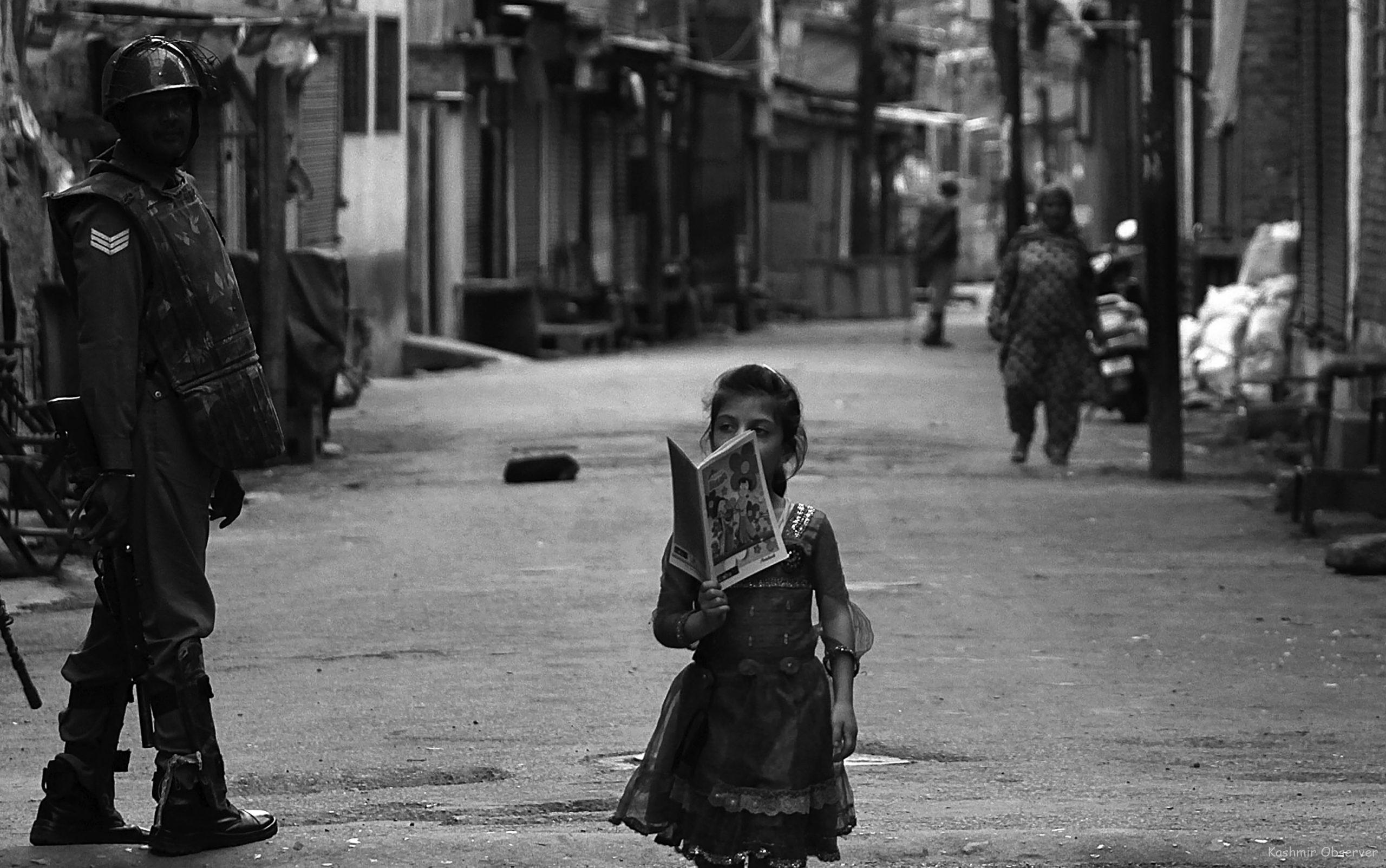 A girl walks past an army personnel in the alleyways of Downtown Srinagar reading into a notebook. File Photo by Abid Bhat for Kashmir Observer (July 6, 2020)
A girl walks past an army personnel in the alleyways of Downtown Srinagar reading into a notebook. File Photo by Abid Bhat for Kashmir Observer (July 6, 2020)
Children in Kashmir steal moments from life to live what’s touted as the standard of a joyful childhood. They live the normal in the abnormal.
A Kagaz ki Kishti, a romp in the rain and a plunge into a dirty puddle — these flash in our mind’s eye at the very first request for childhood’s recollection.
Childhood has dominantly been a symbol of hope, innocence and ecstasy. It has remained the most enduring metaphors for joy and life. This symbolism associated with childhood is so pervasive that all recollections and nostalgia are tainted by these expected connotations.
However, even with the inevitable impact of this formidable symbolism, this representation of childhood is unrepresentative. It has always been.
When we demystify our expectations, we face the bitter truth. We see the dust of poverty on the faces of children, bones of hunger all over their skin and in some cases, we see them resting on their grand pa’s stomach on a random road — a beautiful template — disturbed by death. He has been killed in a crossfire between the army and suspected militants. Childhood’s loss — a collateral.
The dehumanisation of Kashmiri children starts with the nomenclature itself. They’re called Children of “conflict”; an identity which reduces them to their immediate political fate and implicates them immortaly in a cycle of violence.
Children are not deemed agential in the matters of electoral democracies. This stage is often taken to be “apolitical”. However, Kashmiri children do not even have the privilege of having this apolitical innocence. While the Greta Thunbergs of the world fight climate change, Kashmiri children had to switch their placards from “Save the Planet ” to “Return my Baba’s Dead Body”.
Following this week’s Hyderpora shootout where four people including civilians have been killed. The children of these colossal collateral damages have had to endure too much, too soon. Of the four killed in the shootout, only two were reportedly civilians. The meddling with numerics hides behind it the human cost of such events. These two civilians have left behind five children who would have to live their lives without a father now. Even before they reached the adolescent or adult existential dilemmas of “What’s life”, they met the question, “Whose bullet hit him?”
In a world where social media builds up expectations of a beautiful life, Kashmiri children mourning the killings of their loved ones are interrupting the timelines of the privileged world.
They have cameras flashed in their faces and a world waiting for them to say the right things. Children, trying to find the right words, not to fight a case for justice but to just evoke enough empathy in powers that be, to see the face of their dead father.
Consequently, instead of New York dreams, Kashmiri children wonder whether they’d be the next in line to mourn or next up in the line to be frisked.
Kashmir is a minefield of political manoeuvres and is a dangerous flash point of geopolitics. But do children here deserve to suffer?
In Kashmir, children have barely had a smooth sail in school life ever since the Abrogation of Article 370 and the subsequent covid-19 lockdowns. They do not even have the privilege of having the naive hope of escaping these restraints.
This political crisis has left an indelible impact of trauma on Children here. The cases of trauma have been rapidly increasing. According to statistics, 84.7% of people from rural areas and 15.3% from urban areas have depression. From among these, a study revealed that psychiatric morbidity has increased dramatically in the age group of 15 to 25, with the highest prevalence rate of 66.7%.
Children in Kashmir steal moments from life to live what’s touted as the standard of a joyful childhood. They live the normal in the abnormal. In other parts of the world, youth is defined by demographic cohorts like Millennials and Gen Z whereas Kashmiris have childhoods defined by political happenings interspersed in these decades. From kids who lived through the armed insurgency of the 1990s, to the ones who skipped school due to the Amarnath row, and now to the ones who lived through the event of the Abrogation of Article 370 — politics delineates Kashmiri childhood.
It seems to be a never ending road of woes for Kashmir. There is no tangible source of reassurance, only an optimistic hope. However, in this forever postponed quest for peace, children have lost and continue to lose their chances at a dignified and healthy childhood.
A child’s right to a dignified life, education and safety should not stand in jeopardy no matter the political situation.
- Views expressed in the article are the author’s own and do not necessarily represent the editorial stance of Kashmir Observer
Follow this link to join our WhatsApp group: Join Now
Be Part of Quality Journalism |
Quality journalism takes a lot of time, money and hard work to produce and despite all the hardships we still do it. Our reporters and editors are working overtime in Kashmir and beyond to cover what you care about, break big stories, and expose injustices that can change lives. Today more people are reading Kashmir Observer than ever, but only a handful are paying while advertising revenues are falling fast. |
| ACT NOW |
| MONTHLY | Rs 100 | |
| YEARLY | Rs 1000 | |
| LIFETIME | Rs 10000 | |










